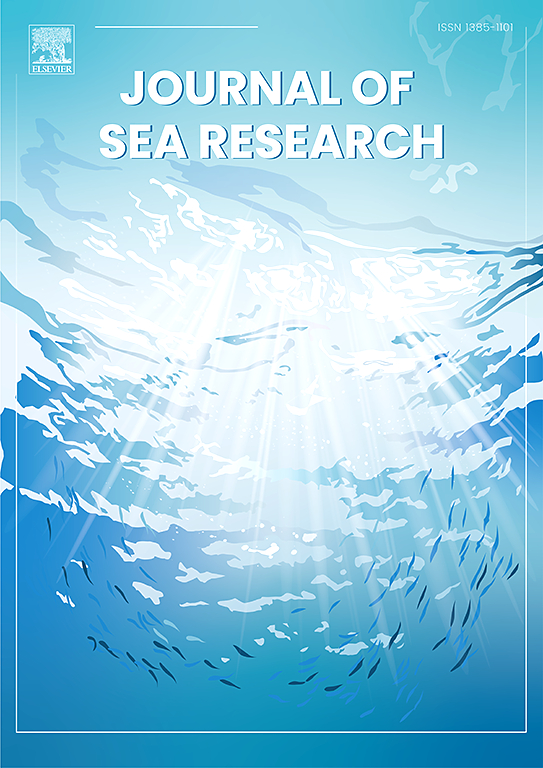Performance of the different parameterization of depth-induced breaking during a typhoon
IF 2.9
4区 地球科学
Q2 MARINE & FRESHWATER BIOLOGY
引用次数: 0
Abstract
This study investigates typhoon-induced wave dynamics using the WAVEWATCH-III (WW3) model, with a focus on evaluating eight depth-induced wave breaking parameterizations under typhoon conditions: BJ78, NE87, RU03, GO10, SA15, LS17, CH19, and TG83. The wind forcing field for WW3 is constructed by assimilating wind products from Haiyang-2 (HY-2), the Soil Moisture Active–Passive (SMAP) radiometer and the Advanced Microwave Scanning Radiometer-2 (AMSR2). The model simulated waves during Typhoons Lekima (2019) and Yagi (2024) incorporating sea surface current speed and sea surface level data from the Copernicus Marine Environment Monitoring Service (CMEMS). Validation against HY-2B satellite significant wave height (SWH) measurements demonstrates that the LS17 outperforms other schemes in shallow coastal regions (< 200 m water depth), achieving optimal metric with a root mean square error (RMSE) of 0.5109 m and a correlation coefficient (Cor) of 0.8748. Comparison with buoy reveals maximum SWH discrepancy of 0.3 m between LS17 and BJ78 in shallow waters (i.e., 13 m water depth). This study evaluates the performance of two wave-breaking parameterizations (BJ78 and LS17) in WW3 simulations against HY-2 observations, with a focus on Super Typhoon Yagi (2024). Results indicate that both schemes perform comparably in deep waters (200–80 m depth), showing minimal deviations (∼0.5 m). However, near the coast (80–0 m), BJ78 exhibits significant underestimation (−2 m bias), while LS17 maintains higher accuracy. The superior performance of LS17 in shallow waters underscores the critical role of wave-breaking parameterization selection for reliable nearshore wave modeling, especially during extreme events such as typhoons.
台风期间不同参数化对深度诱发断裂的影响
本文利用WAVEWATCH-III (WW3)模型研究了台风诱发的波浪动力学,重点评估了8个台风条件下的深度诱发破波参数化:BJ78、NE87、RU03、GO10、SA15、LS17、CH19和TG83。利用海洋2号(HY-2)、土壤湿度主被动辐射计(SMAP)和先进微波扫描辐射计-2 (AMSR2)的风产品,构建了第三次世界大战的风强迫场。该模型结合哥白尼海洋环境监测服务(CMEMS)的海面流速和海平面数据,模拟了台风利基马(2019)和八木(2024)期间的海浪。对HY-2B卫星有效波高(SWH)测量数据的验证表明,LS17方案在浅海地区(<;水深200 m),获得最优度量,均方根误差(RMSE)为0.5109 m,相关系数(Cor)为0.8748。与浮标对比发现,LS17与BJ78在浅水区(即水深13 m)的最大SWH差异为0.3 m。本文以超级台风八木(2024)为研究对象,利用HY-2观测资料,评估了两个破波参数化(BJ78和LS17)在第三次世界大战模拟中的表现。结果表明,这两种方案在深水(200-80 m深度)中表现相当,偏差最小(~ 0.5 m)。然而,在海岸附近(80-0 m), BJ78表现出明显的低估(- 2 m偏差),而LS17保持更高的精度。LS17在浅水区的优异性能凸显了破波参数化选择对于可靠的近岸波浪模拟的关键作用,特别是在台风等极端事件中。
本文章由计算机程序翻译,如有差异,请以英文原文为准。
求助全文
约1分钟内获得全文
求助全文
来源期刊

Journal of Sea Research
地学-海洋学
CiteScore
3.20
自引率
5.00%
发文量
86
审稿时长
6-12 weeks
期刊介绍:
The Journal of Sea Research is an international and multidisciplinary periodical on marine research, with an emphasis on the functioning of marine ecosystems in coastal and shelf seas, including intertidal, estuarine and brackish environments. As several subdisciplines add to this aim, manuscripts are welcome from the fields of marine biology, marine chemistry, marine sedimentology and physical oceanography, provided they add to the understanding of ecosystem processes.
 求助内容:
求助内容: 应助结果提醒方式:
应助结果提醒方式:


